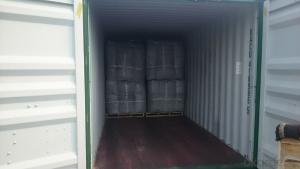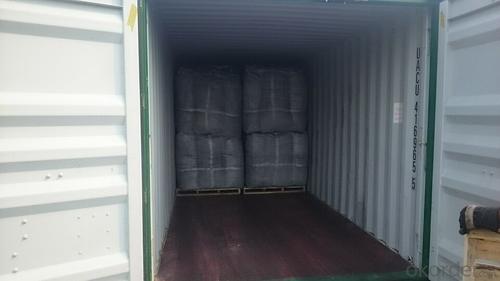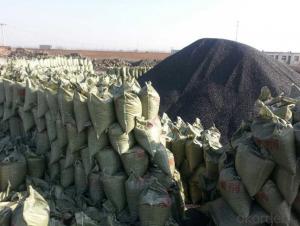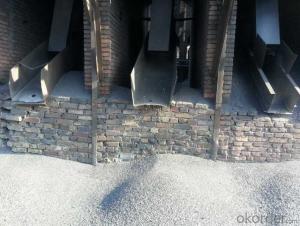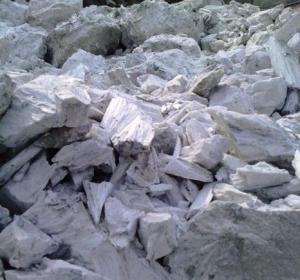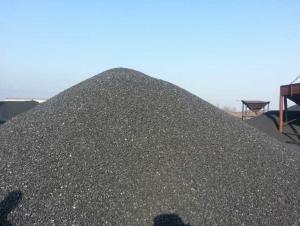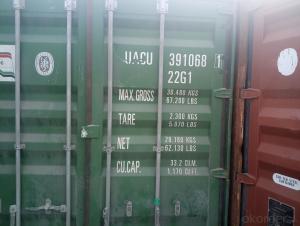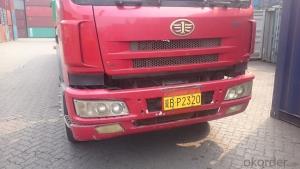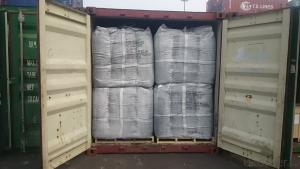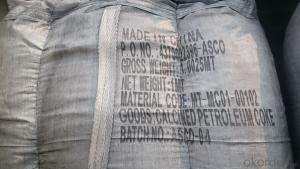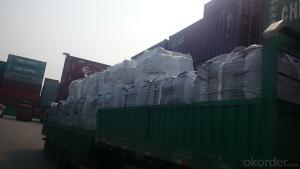Used in EAF as Charge Coke for Steel Mills with Ash 8%max
- Loading Port:
- Tianjin
- Payment Terms:
- TT OR LC
- Min Order Qty:
- 23 m.t.
- Supply Capability:
- 6000 m.t./month
OKorder Service Pledge
OKorder Financial Service
You Might Also Like
Introduction:
Calcined anthracite can be called carbon additive, carbon raiser, recarburizer, injection coke, charging coke, gas calcined anthracite.
Carbon Additive/Calcined Anthracite Coal may substitute massively refinery coke or graphite. Meanwhile its cost is much less than the refinery coke and graphite. Carbon Additive is mainly used in electric steel ovens, water filtering, rust removal in shipbuilding and production of carbon material.
It has good characteristics with low ash, low resistivity, low sulphur, high carbon and high density. It is the best material for high quality carbon products. It is used as carbon additive in steel industry or fuel.
Features:
Best quality Taixi anthracite as raw materials through high temperature calcined at 800-1200 ℃ by the DC electric calciner with results in eliminating the moisture and volatile matter from Anthracite efficiently, improving the density and the electric conductivity and strengthening the mechanical strength and anti-oxidation, It has good characteristics with low ash, low resistivity, low carbon and high density. It is the best material for high quality carbon products, it is used as carbon additive in steel industry or fuel.
Specifications:
F.C.% | 95MIN | 94MIN | 93MIN | 92MIN | 90MIN | 85MIN | 84MIN |
ASH % | 4MAX | 5MAX | 6 MAX | 6.5MAX | 8.5MAX | 12MAX | 13MAX |
V.M.% | 1 MAX | 1MAX | 1.0MAX | 1.5MAX | 1.5MAX | 3 MAX | 3 MAX |
SULFUR % | 0.3MAX | 0.3MAX | 0.3MAX | 0.35MAX | 0.35MAX | 0.5MAX | 0.5MAX |
MOISTURE % | 0.5MAX | 0.5MAX | 0.5MAX | 0.5MAX | 0.5MAX | 1MAX | 1MAX |
Pictures
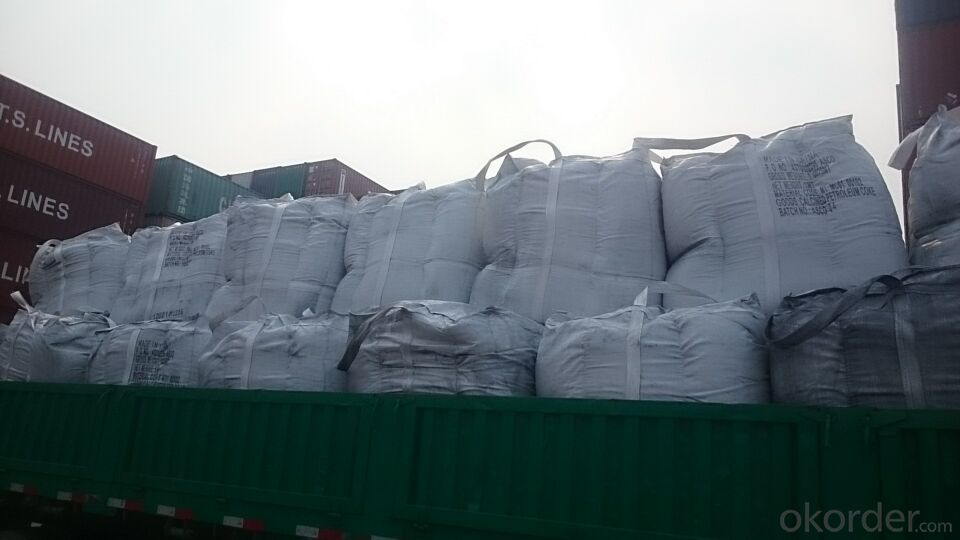
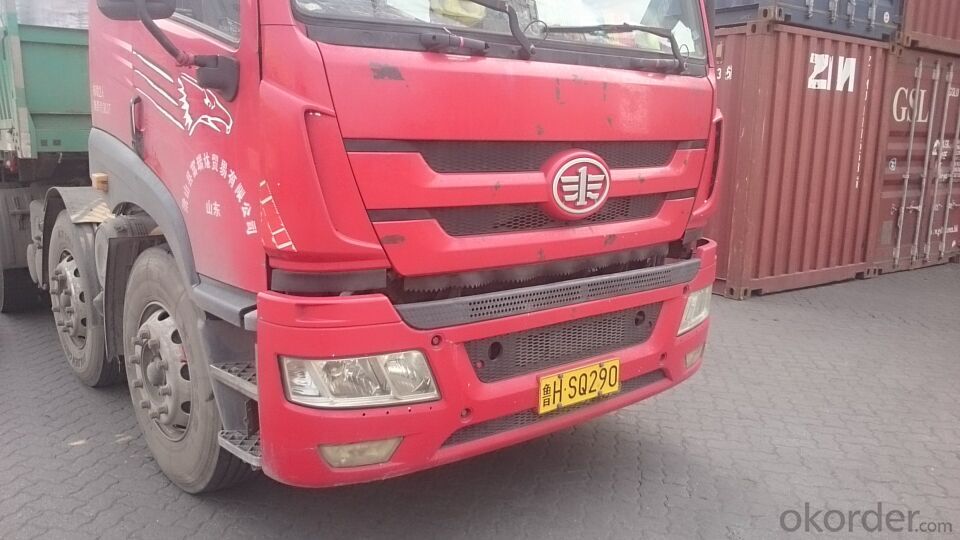
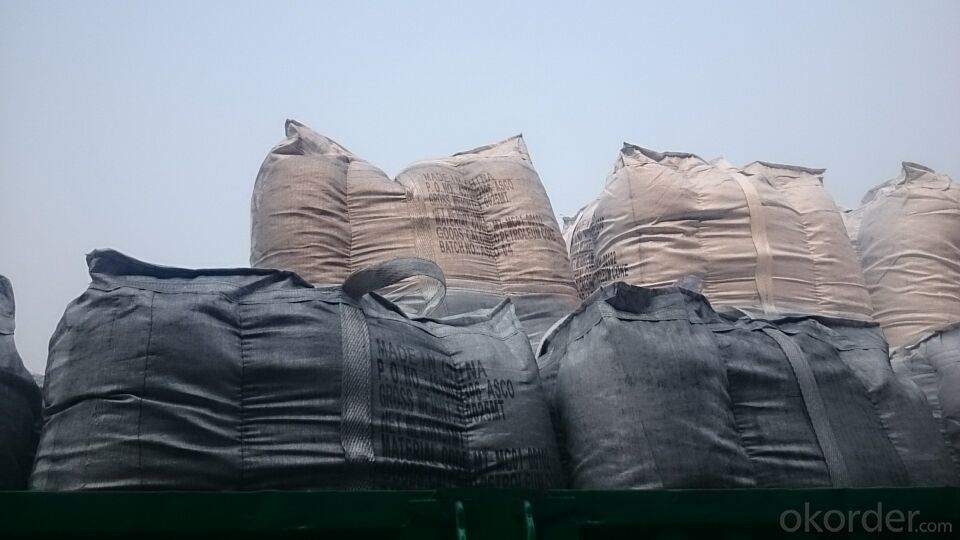

FAQ:
Packing:
(1). Waterproof jumbo bags: 800kgs~1100kgs/ bag according to different grain sizes;
(2). Waterproof PP woven bags / Paper bags: 5kg / 7.5kg / 12.5kg / 20kg / 25kg / 30kg / 50kg small bags;
(3). Small bags into jumbo bags: waterproof PP woven bags / paper bags in 800kg ~1100kg jumbo bags.
Payment terms
20% down payment and 80% against copy of B/L.
Workable LC at sight,
- Q: What are the effects of ocean acidification on marine life?
- The detrimental effects of ocean acidification on marine life are substantial. The primary reason for this phenomenon is the rise in carbon dioxide (CO2) emissions, which the oceans absorb and cause a decrease in pH levels. This increasing acidity has profound consequences for a variety of marine organisms and ecosystems. Shell-forming organisms, such as corals, mollusks, and certain plankton, are among the most vulnerable groups affected by ocean acidification. The acidity reduces the availability of carbonate ions, which are crucial for these organisms to construct and upkeep their shells or skeletons. Consequently, their growth and development are hindered, making them more susceptible to predation and extinction. This not only impacts these specific species but also disrupts the entire food chain since they serve as a vital food source for numerous other marine organisms. Moreover, ocean acidification has negative effects on the physiology and behavior of various marine organisms. Research has indicated that it can impair the ability of fish to detect predators, find food, and navigate, leading to decreased survival rates and modified migratory patterns. Additionally, acidification can disrupt reproductive processes, such as the growth and survival of fish larvae, resulting in population declines and reduced biodiversity. Coral reefs, often referred to as the "rainforests of the sea," are especially susceptible to ocean acidification. The increased acidity hampers the calcification process necessary for coral growth, making them more prone to bleaching and death. As coral reefs provide essential habitats for numerous marine species, their decline would have a cascading impact on the entire ecosystem. Lastly, ocean acidification also affects the equilibrium of marine ecosystems by changing the composition and abundance of various species. Some organisms, like certain types of algae, may actually benefit from elevated CO2 levels and thrive, causing an imbalance in the ecosystem. This can result in the dominance of specific species, negatively impacting overall biodiversity and the stability of the marine environment. In conclusion, ocean acidification presents significant dangers to marine life. It disrupts the growth and development of shell-forming organisms, impairs the physiology and behavior of various marine species, damages coral reefs, and alters the composition of marine ecosystems. Addressing this issue is crucial to safeguard marine biodiversity, sustain fisheries, and maintain the overall health of our oceans.
- Q: What are the consequences of increased carbon emissions on social inequality?
- Increased carbon emissions have significant consequences on social inequality. Firstly, the impacts of climate change, driven by carbon emissions, disproportionately affect marginalized communities who often lack the resources and infrastructure to adapt or recover from extreme weather events, such as floods, droughts, and storms. This exacerbates existing inequalities and widens the gap between the rich and the poor. Secondly, the burning of fossil fuels, a major contributor to carbon emissions, disproportionately affects low-income communities who are more likely to live near industrial areas or power plants. This exposure to air pollution leads to higher rates of respiratory diseases and other health issues, further deepening social inequality as access to quality healthcare is often limited for these communities. Moreover, the consequences of climate change, such as agricultural disruptions, water scarcity, and increased food prices, can lead to social unrest, migration, and conflicts, disproportionately impacting vulnerable populations. This creates a ripple effect on social and economic stability, further marginalizing already disadvantaged groups. Addressing carbon emissions and mitigating climate change is crucial for reducing social inequality. Transitioning to renewable energy sources, investing in sustainable infrastructure, and implementing policies that prioritize the needs of marginalized communities can help alleviate the burden on those most affected and promote a more equitable society.
- Q: What is carbon black filler?
- Carbon black filler is a type of additive that is commonly used in the production of rubber and plastic products. It is a fine, powdery substance that is derived from the incomplete combustion of hydrocarbons, such as oil or natural gas. Carbon black filler is composed primarily of elemental carbon, with small amounts of other elements such as hydrogen, oxygen, and sulfur. The main purpose of using carbon black filler is to improve the physical properties of rubber and plastic materials. It is added to enhance the strength, durability, and wear resistance of the final product. Carbon black filler also helps to increase the stiffness and hardness of the material, making it more suitable for various applications. In addition to its mechanical properties, carbon black filler also provides other benefits. It acts as a reinforcing agent, increasing the tensile strength and tear resistance of rubber compounds. It also enhances the electrical conductivity of the material, making it useful in applications where static electricity needs to be dissipated. Moreover, carbon black filler helps to protect the material from the harmful effects of UV radiation and ozone. It acts as a UV stabilizer and antioxidant, preventing degradation and prolonging the lifespan of the product. Carbon black filler also improves the thermal conductivity of rubber and plastic materials, aiding in heat dissipation. Overall, carbon black filler is a versatile and widely used additive in the manufacturing industry. Its unique properties make it an essential component in the production of a wide range of rubber and plastic products, including tires, conveyor belts, hoses, gaskets, and many more.
- Q: What is carbon nanoelectronics?
- The field of research and development known as carbon nanoelectronics focuses on using carbon-based materials, like carbon nanotubes or graphene, to create and advance electronic devices and components on a nanoscale level. These tiny carbon structures have unique electrical properties that make them highly desirable for a wide range of electronic devices, including transistors, sensors, and interconnects. One of the main advantages of carbon nanoelectronics is the exceptional electrical conductivity and thermal properties of carbon nanomaterials. For example, carbon nanotubes have excellent electrical conductivity, comparable to copper, but with a much smaller size. This allows for the creation of smaller and more efficient electronic devices, leading to advancements in miniaturization and energy efficiency. Another important aspect of carbon nanoelectronics is the incredible strength and flexibility of carbon nanomaterials. Graphene and other carbon-based structures have exceptional mechanical properties, making them highly durable and resilient. This makes it possible to produce flexible and wearable electronic devices that can adapt to different surfaces, opening up new opportunities for electronics design and integration. Furthermore, carbon nanoelectronics offers the potential for high-speed and low-power electronic devices. Carbon nanomaterials have unique electronic properties that allow them to carry electric charge at extremely high speeds, making them suitable for high-frequency applications. Additionally, the low power consumption of carbon nanomaterials can lead to the development of energy-efficient electronic devices. In conclusion, carbon nanoelectronics has the potential to revolutionize the field of electronics by enabling the creation of smaller, faster, and more energy-efficient devices. Ongoing research and development in this field are expected to bring about breakthroughs in various industries, such as computing, telecommunications, healthcare, and energy.
- Q: What are the impacts of carbon emissions on indigenous communities?
- Indigenous communities are greatly affected by carbon emissions, which have significant impacts on their environment, culture, health, and overall well-being. One of the main consequences is the degradation of their traditional lands and natural resources, which are crucial for their livelihoods, including hunting, fishing, and agriculture. The increase in carbon emissions leads to climate change, resulting in changes in temperature, weather patterns, and ecosystems. This disrupts the delicate balance of their ecosystems and makes it more challenging for them to sustain their way of life. The loss of traditional lands and resources also has profound cultural implications for indigenous communities. Their connection to the land is deeply rooted in their identity and spirituality. When their lands are degraded or destroyed due to carbon emissions, it erodes their cultural practices, knowledge, and traditions. This loss of cultural heritage affects not only indigenous communities but also the global society, as their unique knowledge about sustainable land management and conservation practices can offer valuable insights for addressing climate change and protecting the planet. Moreover, carbon emissions contribute to air pollution, which severely impacts the health of indigenous communities. Many indigenous communities live near industrial facilities or fossil fuel extraction sites, leading to increased exposure to pollutants such as particulate matter, sulfur dioxide, and nitrogen oxides. These pollutants cause respiratory illnesses, cardiovascular diseases, and other health issues, disproportionately affecting vulnerable members of these communities, including children and the elderly. In addition to immediate health impacts, the long-term consequences of carbon emissions, such as rising sea levels and extreme weather events, pose further threats to the existence of indigenous communities. Many indigenous communities reside in low-lying coastal areas or remote regions that are more susceptible to the effects of climate change, including coastal erosion, flooding, and loss of traditional food sources. These changes not only disrupt their way of life but also force them to consider relocation, resulting in the loss of their cultural identity and connection to their ancestral lands. Addressing carbon emissions and mitigating climate change is crucial for the well-being and survival of indigenous communities. It involves recognizing their rights to their traditional lands, resources, and self-determination, as well as involving them in decision-making processes regarding environmental conservation. Supporting sustainable development projects that prioritize local needs and indigenous knowledge can help foster resilient communities that can adapt to the changing climate. Ultimately, by reducing carbon emissions and protecting the environment, we can preserve the cultural diversity and invaluable contributions of indigenous communities for future generations.
- Q: What are the properties of carbon-based adhesives?
- Carbon-based adhesives have several properties that make them versatile and widely used in various industries. Firstly, carbon-based adhesives are known for their excellent bonding strength. They have the ability to create strong and durable bonds between different materials, including metals, plastics, ceramics, and composites. This makes them suitable for applications where a reliable and long-lasting bond is required. Another important property of carbon-based adhesives is their high temperature resistance. They can withstand extreme temperatures without losing their adhesive properties, making them ideal for applications in high-temperature environments. This property also allows carbon-based adhesives to be used in industries such as aerospace and automotive, where components are subjected to elevated temperatures. Carbon-based adhesives also possess good chemical resistance, meaning they can withstand exposure to various chemicals without degradation. This property makes them suitable for use in industries where adhesives may come into contact with solvents, fuels, or harsh chemicals. Additionally, carbon-based adhesives exhibit excellent electrical conductivity. This property allows them to be used in applications where electrical or thermal conductivity is required, such as in the electronics industry. Furthermore, carbon-based adhesives often have low shrinkage and low outgassing characteristics. This means that they do not significantly change in size or release volatile substances during curing, minimizing the risk of damage or contamination to surrounding materials. Overall, carbon-based adhesives offer a combination of high bonding strength, temperature resistance, chemical resistance, electrical conductivity, and dimensional stability, making them a preferred choice in various industries where reliable and durable bonding solutions are needed.
- Q: How can carbon be stored underground?
- Carbon can be stored underground through a process called carbon capture and storage (CCS). This involves capturing carbon dioxide (CO2) emissions from industrial sources, such as power plants or cement factories, and then storing it deep underground in geological formations. The first step in this process is capturing the CO2 emissions before they are released into the atmosphere. There are several technologies available for this, including post-combustion capture, pre-combustion capture, and oxy-fuel combustion. These technologies separate the CO2 from other gases, such as nitrogen, and produce a concentrated stream of CO2 that can be easily stored. Once the CO2 is captured, it needs to be transported to a suitable storage site. This is typically done through pipelines or ships, depending on the distance and the location of the storage site. The CO2 is then injected deep underground into geological formations, such as depleted oil and gas reservoirs, saline aquifers, or coal seams. The storage sites are carefully selected based on their ability to securely and permanently store the CO2. The geological formations must have a layer of impermeable rock above them, known as a caprock, to prevent the CO2 from leaking back to the surface. The sites are also monitored regularly to ensure the stored CO2 remains securely underground. Storing carbon underground can significantly reduce CO2 emissions and help mitigate climate change. It effectively prevents the release of CO2 into the atmosphere, where it would contribute to the greenhouse effect and global warming. Furthermore, CCS can be combined with enhanced oil recovery (EOR) techniques, where the injected CO2 is used to extract more oil from depleted reservoirs, making the process economically viable. However, it is important to note that carbon storage is not a permanent solution to climate change. It can play a role in reducing emissions while transitioning to cleaner energy sources, but it should not replace efforts to decarbonize the economy and reduce reliance on fossil fuels. Additionally, the long-term safety and environmental impacts of storing carbon underground need to be thoroughly studied and understood to ensure its effectiveness and sustainability.
- Q: Which carbon content is larger, steel or pig iron?
- carbon content more than 2.11% of iron, iron carbon content in general industry 2.5%--4%. I hope I can help you.
- Q: How is carbon dioxide released into the atmosphere?
- Carbon dioxide is emitted into the atmosphere due to a range of natural and human activities. The burning of fossil fuels, like coal, oil, and natural gas, for energy generation is one of the main sources of carbon dioxide. Combustion of these fuels releases carbon dioxide as a byproduct, which occurs in power plants, factories, and vehicles that rely on fossil fuels for energy. Deforestation and changes in land use also contribute to the release of carbon dioxide into the atmosphere. Through photosynthesis, trees absorb carbon dioxide, and when they are cut down or burned, the stored carbon is released back into the atmosphere. This is especially significant in tropical rainforests, which store large amounts of carbon in their vegetation. Furthermore, natural processes like respiration and volcanic eruptions release carbon dioxide into the atmosphere. In respiration, living organisms, including humans and animals, take in oxygen and exhale carbon dioxide as a waste product. Volcanic eruptions release carbon dioxide that was stored in magma and rock formations. In general, the release of carbon dioxide into the atmosphere is a combination of natural and human activities. However, human activities, particularly the burning of fossil fuels and deforestation, have significantly raised the levels of carbon dioxide in the atmosphere, resulting in the greenhouse effect and climate change.
- Q: other parameters are figured out, the difference is only in the carbon and carbon is not very clear, just know that they are winding mode is the opposite, there are two kinds of most printers can be used, what is the difference between the performance of them? Two can use the printer in the selection of the best carbon or carbon? Why? Please cite several models as an example.Please answer in your own words. Don't factor,
- SATO machine with carbon is better, and the CITIZEN printer inside and outside carbon can be used, in addition to machine limitations, not what the difference is too big, the quality of internal and external carbon ribbon is the same.
Send your message to us
Used in EAF as Charge Coke for Steel Mills with Ash 8%max
- Loading Port:
- Tianjin
- Payment Terms:
- TT OR LC
- Min Order Qty:
- 23 m.t.
- Supply Capability:
- 6000 m.t./month
OKorder Service Pledge
OKorder Financial Service
Similar products
Hot products
Hot Searches
